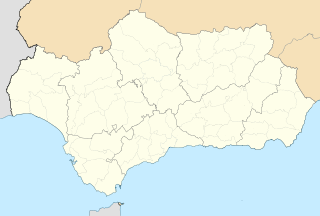Cueva de los Murciélagos
| Cueva de los Murciélagos
|
||
|---|---|---|
|
Main entrance (Cueva Grande) of the cave |
||
| Location: | Sierras Subbéticas , Spain | |
| Height : | 980 msnm | |
|
Geographic location: |
37 ° 32 '30.9 " N , 4 ° 18' 15.6" W | |
|
|
||
| Geology: | Betic Cordillera | |
| Discovery: | 1868 | |
| Lighting: | electric | |
| Overall length: | 2,000 meters | |
| Length of the show cave area: |
450 meters | |
| Website: | Cueva de los Murciélagos | |
Cueva de los Murciélagos describes a cave system that is located in the Sierras Subbéticas in the south of the province of Cordoba in Spain . It is located about four kilometers south-east of the municipality of Zuheros and is considered the most important of the around 60 caves in the Parque Natural de Sierras Subbéticas due to the unique rock paintings and significant archaeological finds from the Neolithic period . Although the caves were discovered in 1868, they were not explored until 1938. In addition, they are home to one of the most important bat colonies in Andalusia .
The caves are located in an extensive karst landscape in the 1,000 meter high Canada de Malos Vientos mountain in southern Andalusia and are 980 meters above sea level. The spectacular rock formations and caves with stalagmites , stalactites and underground lakes are the result of weathering and leaching of the carbonate rock . The caves have a total extension of 2,000 meters, of which only 450 meters can be visited.
The cave explorers discovered graves from the middle Paleolithic , which indicate human settlement around 35,000 years ago. Finds from the Neolithic could be radiocarbon dating from 4,300 to 3,980 BC. To be dated. The researchers reconstructed the lives of the people whose relics were preferably to be found at the cave entrance. Here they cooked meals over an open fire. Their diet consisted of the meat of wild and farmed animals and various types of grain. They used flint and bone tools to cut leather with. They made vessels painted red, as well as necklaces and bracelets from seashells, which they probably acquired through trade with coastal inhabitants. Apparently the group was transitioning from being a hunter-gatherer to a farmer growing crops and raising domestic animals.
There are cave paintings on various walls , for example the representation of goats, an eye and several human figures. The drawings all date from the Neolithic Age (6,000-3,000 BC) and the Bronze Age (3,000-2,000 BC).
literature
- Barry Cunliffe (ed.): Illustrated pre- and early history of Europe. Frankfurt 1996, ISBN 3-593-35562-0 .
Individual evidence
- ↑ a b Cueva de los Murciélagos
- ↑ a b Cave near Zuheros ( Memento of the original from April 9, 2003 in the Internet Archive ) Info: The archive link has been inserted automatically and has not yet been checked. Please check the original and archive link according to the instructions and then remove this notice.

